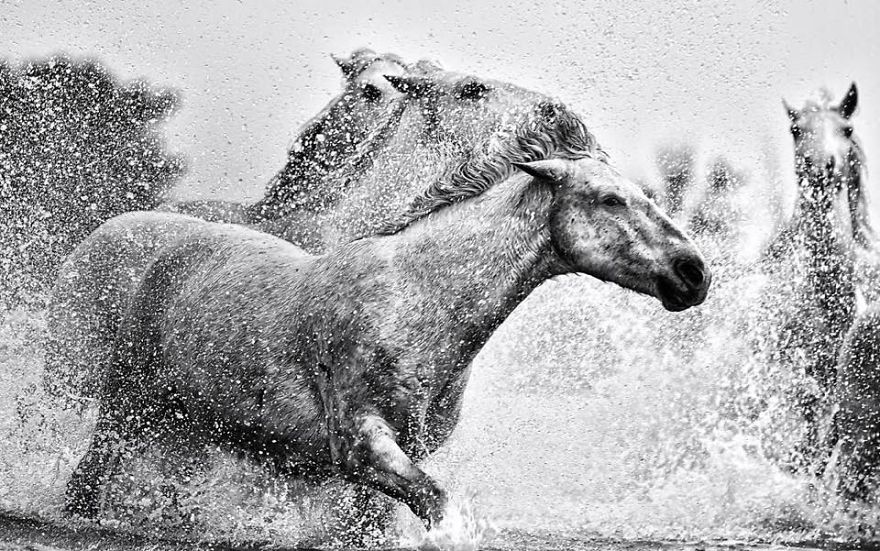Their white appearance in winter makes the Arctic fox an interesting subject for wildlife photographers. In this article, I want to share with you my experience. Who does not dream about taking photos of a white fox in a snowy landscape? However, an encounter during summer is also something that shouldn’t be forgotten!
A couple of years ago, I was lucky enough to encounter an Arctic fox during the Arctic summer in Scandinavia. I was hiking through the mountains when golden plovers started to call and, all of a sudden, I spotted a strange animal – brown/grey fur and rather small size.
Their white appearance in winter makes the Arctic fox an interesting subject for wildlife photographers. In this article, I want to share with you my experience. Who does not dream about taking photos of a white fox in a snowy landscape? However, an encounter during summer is also something that shouldn’t be forgotten!
A couple of years ago, I was lucky enough to encounter an Arctic fox during the Arctic summer in Scandinavia. I was hiking through the mountains when golden plovers started to call and, all of a sudden, I spotted a strange animal – brown/grey fur and rather small size.
It was situation I always dreamed of, but never imagined I would ever witness. An Arctic fox ran down the gravel road, golden plovers making their alarm calls as I was standing there, totally perplexed by the surreal situation.
 https://cdn.naturettl.com/wp-content/uploads/2020/05/15160401/how-to-photograph-arctic-foxes-7-300x200.jpg 300w, https://cdn.naturettl.com/wp-content/uploads/2020/05/15160401/how-to-photograph-arctic-foxes-7-1024x683.jpg 1024w, https://cdn.naturettl.com/wp-content/uploads/2020/05/15160401/how-to-photograph-arctic-foxes-7-768x512.jpg 768w, https://cdn.naturettl.com/wp-content/uploads/2020/05/15160401/how-to-photograph-arctic-foxes-7-1536x1024.jpg 1536w, https://cdn.naturettl.com/wp-content/uploads/2020/05/15160401/how-to-photograph-arctic-foxes-7-550x367.jpg 550w, https://cdn.naturettl.com/wp-content/uploads/2020/05/15160401/how-to-photograph-arctic-foxes-7-900x600.jpg 900w, https://cdn.naturettl.com/wp-content/uploads/2020/05/15160401/how-to-photograph-arctic-foxes-7.jpg 1600w" alt="Arctic Fox walking" width="800" height="534" data-wp-pid="19662" data-lazy-srcset="https://cdn.naturettl.com/wp-content/uploads/2020/05/15160401/how-to-photograph-arctic-foxes-7-800x534.jpg 800w, https://cdn.naturettl.com/wp-content/uploads/2020/05/15160401/how-to-photograph-arctic-foxes-7-300x200.jpg 300w, https://cdn.naturettl.com/wp-content/uploads/2020/05/15160401/how-to-photograph-arctic-foxes-7-1024x683.jpg 1024w, https://cdn.naturettl.com/wp-content/uploads/2020/05/15160401/how-to-photograph-arctic-foxes-7-768x512.jpg 768w, https://cdn.naturettl.com/wp-content/uploads/2020/05/15160401/how-to-photograph-arctic-foxes-7-1536x1024.jpg 1536w, https://cdn.naturettl.com/wp-content/uploads/2020/05/15160401/how-to-photograph-arctic-foxes-7-550x367.jpg 550w, https://cdn.naturettl.com/wp-content/uploads/2020/05/15160401/how-to-photograph-arctic-foxes-7-900x600.jpg 900w, https://cdn.naturettl.com/wp-content/uploads/2020/05/15160401/how-to-photograph-arctic-foxes-7.jpg 1600w" data-lazy-sizes="(max-width: 800px) 100vw, 800px" data-jpibfi-post-excerpt="" data-jpibfi-post-url="https://www.naturettl.com/how-to-photograph-arctic-foxes/" data-jpibfi-post-title="How to Photograph Arctic Foxes" data-jpibfi-src="https://cdn.naturettl.com/wp-content/uploads/2020/05/15160401/how-to-photograph-arctic-foxes-7-800x534.jpg" data-lazy-src="https://cdn.naturettl.com/wp-content/uploads/2020/05/15160401/how-to-photograph-arctic-foxes-7-800x534.jpg" data-ll-status="loaded" data-jpibfi-indexer="1" />
https://cdn.naturettl.com/wp-content/uploads/2020/05/15160401/how-to-photograph-arctic-foxes-7-300x200.jpg 300w, https://cdn.naturettl.com/wp-content/uploads/2020/05/15160401/how-to-photograph-arctic-foxes-7-1024x683.jpg 1024w, https://cdn.naturettl.com/wp-content/uploads/2020/05/15160401/how-to-photograph-arctic-foxes-7-768x512.jpg 768w, https://cdn.naturettl.com/wp-content/uploads/2020/05/15160401/how-to-photograph-arctic-foxes-7-1536x1024.jpg 1536w, https://cdn.naturettl.com/wp-content/uploads/2020/05/15160401/how-to-photograph-arctic-foxes-7-550x367.jpg 550w, https://cdn.naturettl.com/wp-content/uploads/2020/05/15160401/how-to-photograph-arctic-foxes-7-900x600.jpg 900w, https://cdn.naturettl.com/wp-content/uploads/2020/05/15160401/how-to-photograph-arctic-foxes-7.jpg 1600w" alt="Arctic Fox walking" width="800" height="534" data-wp-pid="19662" data-lazy-srcset="https://cdn.naturettl.com/wp-content/uploads/2020/05/15160401/how-to-photograph-arctic-foxes-7-800x534.jpg 800w, https://cdn.naturettl.com/wp-content/uploads/2020/05/15160401/how-to-photograph-arctic-foxes-7-300x200.jpg 300w, https://cdn.naturettl.com/wp-content/uploads/2020/05/15160401/how-to-photograph-arctic-foxes-7-1024x683.jpg 1024w, https://cdn.naturettl.com/wp-content/uploads/2020/05/15160401/how-to-photograph-arctic-foxes-7-768x512.jpg 768w, https://cdn.naturettl.com/wp-content/uploads/2020/05/15160401/how-to-photograph-arctic-foxes-7-1536x1024.jpg 1536w, https://cdn.naturettl.com/wp-content/uploads/2020/05/15160401/how-to-photograph-arctic-foxes-7-550x367.jpg 550w, https://cdn.naturettl.com/wp-content/uploads/2020/05/15160401/how-to-photograph-arctic-foxes-7-900x600.jpg 900w, https://cdn.naturettl.com/wp-content/uploads/2020/05/15160401/how-to-photograph-arctic-foxes-7.jpg 1600w" data-lazy-sizes="(max-width: 800px) 100vw, 800px" data-jpibfi-post-excerpt="" data-jpibfi-post-url="https://www.naturettl.com/how-to-photograph-arctic-foxes/" data-jpibfi-post-title="How to Photograph Arctic Foxes" data-jpibfi-src="https://cdn.naturettl.com/wp-content/uploads/2020/05/15160401/how-to-photograph-arctic-foxes-7-800x534.jpg" data-lazy-src="https://cdn.naturettl.com/wp-content/uploads/2020/05/15160401/how-to-photograph-arctic-foxes-7-800x534.jpg" data-ll-status="loaded" data-jpibfi-indexer="1" />
Where can you find Arctic foxes?
Arctic foxes live in the tundra regions of the Northern Hemisphere all around the globe. You would, therefore, find them in Russia, Canada, Greenland, Iceland, etc. Some live in the mountain areas, whilst others inhabit the coastlines.
The costal Arctic foxes generally belong to the blue morph. During summertime, they have completely brown fur that turns brown-bluish in wintertime. However, the best-known morph is the white one.
Foxes of the Scandinavian mountain regions mainly belong to the white morph. During summertime, they have a brown-white colouration that turns into a white winter coat in autumn.
Explore the Hub: Arctic fox Pictures
 https://cdn.naturettl.com/wp-content/uploads/2020/05/15160108/how-to-photograph-arctic-foxes-3-300x200.jpg 300w, https://cdn.naturettl.com/wp-content/uploads/2020/05/15160108/how-to-photograph-arctic-foxes-3-1024x683.jpg 1024w, https://cdn.naturettl.com/wp-content/uploads/2020/05/15160108/how-to-photograph-arctic-foxes-3-768x512.jpg 768w, https://cdn.naturettl.com/wp-content/uploads/2020/05/15160108/how-to-photograph-arctic-foxes-3-1536x1024.jpg 1536w, https://cdn.naturettl.com/wp-content/uploads/2020/05/15160108/how-to-photograph-arctic-foxes-3-550x367.jpg 550w, https://cdn.naturettl.com/wp-content/uploads/2020/05/15160108/how-to-photograph-arctic-foxes-3-900x600.jpg 900w, https://cdn.naturettl.com/wp-content/uploads/2020/05/15160108/how-to-photograph-arctic-foxes-3.jpg 1600w" alt="Arctic Fox in summer fur" width="800" height="534" data-wp-pid="19658" data-lazy-srcset="https://cdn.naturettl.com/wp-content/uploads/2020/05/15160108/how-to-photograph-arctic-foxes-3-800x534.jpg 800w, https://cdn.naturettl.com/wp-content/uploads/2020/05/15160108/how-to-photograph-arctic-foxes-3-300x200.jpg 300w, https://cdn.naturettl.com/wp-content/uploads/2020/05/15160108/how-to-photograph-arctic-foxes-3-1024x683.jpg 1024w, https://cdn.naturettl.com/wp-content/uploads/2020/05/15160108/how-to-photograph-arctic-foxes-3-768x512.jpg 768w, https://cdn.naturettl.com/wp-content/uploads/2020/05/15160108/how-to-photograph-arctic-foxes-3-1536x1024.jpg 1536w, https://cdn.naturettl.com/wp-content/uploads/2020/05/15160108/how-to-photograph-arctic-foxes-3-550x367.jpg 550w, https://cdn.naturettl.com/wp-content/uploads/2020/05/15160108/how-to-photograph-arctic-foxes-3-900x600.jpg 900w, https://cdn.naturettl.com/wp-content/uploads/2020/05/15160108/how-to-photograph-arctic-foxes-3.jpg 1600w" data-lazy-sizes="(max-width: 800px) 100vw, 800px" data-jpibfi-post-excerpt="" data-jpibfi-post-url="https://www.naturettl.com/how-to-photograph-arctic-foxes/" data-jpibfi-post-title="How to Photograph Arctic Foxes" data-jpibfi-src="https://cdn.naturettl.com/wp-content/uploads/2020/05/15160108/how-to-photograph-arctic-foxes-3-800x534.jpg" data-lazy-src="https://cdn.naturettl.com/wp-content/uploads/2020/05/15160108/how-to-photograph-arctic-foxes-3-800x534.jpg" data-ll-status="loaded" data-jpibfi-indexer="2" />
https://cdn.naturettl.com/wp-content/uploads/2020/05/15160108/how-to-photograph-arctic-foxes-3-300x200.jpg 300w, https://cdn.naturettl.com/wp-content/uploads/2020/05/15160108/how-to-photograph-arctic-foxes-3-1024x683.jpg 1024w, https://cdn.naturettl.com/wp-content/uploads/2020/05/15160108/how-to-photograph-arctic-foxes-3-768x512.jpg 768w, https://cdn.naturettl.com/wp-content/uploads/2020/05/15160108/how-to-photograph-arctic-foxes-3-1536x1024.jpg 1536w, https://cdn.naturettl.com/wp-content/uploads/2020/05/15160108/how-to-photograph-arctic-foxes-3-550x367.jpg 550w, https://cdn.naturettl.com/wp-content/uploads/2020/05/15160108/how-to-photograph-arctic-foxes-3-900x600.jpg 900w, https://cdn.naturettl.com/wp-content/uploads/2020/05/15160108/how-to-photograph-arctic-foxes-3.jpg 1600w" alt="Arctic Fox in summer fur" width="800" height="534" data-wp-pid="19658" data-lazy-srcset="https://cdn.naturettl.com/wp-content/uploads/2020/05/15160108/how-to-photograph-arctic-foxes-3-800x534.jpg 800w, https://cdn.naturettl.com/wp-content/uploads/2020/05/15160108/how-to-photograph-arctic-foxes-3-300x200.jpg 300w, https://cdn.naturettl.com/wp-content/uploads/2020/05/15160108/how-to-photograph-arctic-foxes-3-1024x683.jpg 1024w, https://cdn.naturettl.com/wp-content/uploads/2020/05/15160108/how-to-photograph-arctic-foxes-3-768x512.jpg 768w, https://cdn.naturettl.com/wp-content/uploads/2020/05/15160108/how-to-photograph-arctic-foxes-3-1536x1024.jpg 1536w, https://cdn.naturettl.com/wp-content/uploads/2020/05/15160108/how-to-photograph-arctic-foxes-3-550x367.jpg 550w, https://cdn.naturettl.com/wp-content/uploads/2020/05/15160108/how-to-photograph-arctic-foxes-3-900x600.jpg 900w, https://cdn.naturettl.com/wp-content/uploads/2020/05/15160108/how-to-photograph-arctic-foxes-3.jpg 1600w" data-lazy-sizes="(max-width: 800px) 100vw, 800px" data-jpibfi-post-excerpt="" data-jpibfi-post-url="https://www.naturettl.com/how-to-photograph-arctic-foxes/" data-jpibfi-post-title="How to Photograph Arctic Foxes" data-jpibfi-src="https://cdn.naturettl.com/wp-content/uploads/2020/05/15160108/how-to-photograph-arctic-foxes-3-800x534.jpg" data-lazy-src="https://cdn.naturettl.com/wp-content/uploads/2020/05/15160108/how-to-photograph-arctic-foxes-3-800x534.jpg" data-ll-status="loaded" data-jpibfi-indexer="2" />
I followed the fox with great distance. Soon I realised he had a lemming in his mouth and he was on the move to a specific place. I sat down with my binoculars and watched the scene.
The fox did not stop for several kilometres until I saw another fox. All of a sudden, many more appeared in my field of view – Arctic fox pups. I knew that I had to come up with a plan on how to take photos of these animals.
How do Arctic foxes live?
Arctic foxes live in dens – sometimes for several generations – and these dens can reach substantial dimensions. They like to dig in frost-free areas with south-faced exposition.
Depending on food availability, Arctic foxes can have litters of up to 18 pups, and often females of the previous year’s litter remain with their parents to help feed and take care of the pups.
Foxes fertilise the area around the dens over time, making these places greener compared to the rest of the landscape. This is the best way to spot a den over long distances with your binoculars.
 https://cdn.naturettl.com/wp-content/uploads/2020/05/15160058/how-to-photograph-arctic-foxes-6-300x200.jpg 300w, https://cdn.naturettl.com/wp-content/uploads/2020/05/15160058/how-to-photograph-arctic-foxes-6-1024x683.jpg 1024w, https://cdn.naturettl.com/wp-content/uploads/2020/05/15160058/how-to-photograph-arctic-foxes-6-768x512.jpg 768w, https://cdn.naturettl.com/wp-content/uploads/2020/05/15160058/how-to-photograph-arctic-foxes-6-1536x1024.jpg 1536w, https://cdn.naturettl.com/wp-content/uploads/2020/05/15160058/how-to-photograph-arctic-foxes-6-550x367.jpg 550w, https://cdn.naturettl.com/wp-content/uploads/2020/05/15160058/how-to-photograph-arctic-foxes-6-900x600.jpg 900w, https://cdn.naturettl.com/wp-content/uploads/2020/05/15160058/how-to-photograph-arctic-foxes-6.jpg 1600w" alt="Pair of Arctic Foxes" width="800" height="534" data-wp-pid="19655" data-lazy-srcset="https://cdn.naturettl.com/wp-content/uploads/2020/05/15160058/how-to-photograph-arctic-foxes-6-800x534.jpg 800w, https://cdn.naturettl.com/wp-content/uploads/2020/05/15160058/how-to-photograph-arctic-foxes-6-300x200.jpg 300w, https://cdn.naturettl.com/wp-content/uploads/2020/05/15160058/how-to-photograph-arctic-foxes-6-1024x683.jpg 1024w, https://cdn.naturettl.com/wp-content/uploads/2020/05/15160058/how-to-photograph-arctic-foxes-6-768x512.jpg 768w, https://cdn.naturettl.com/wp-content/uploads/2020/05/15160058/how-to-photograph-arctic-foxes-6-1536x1024.jpg 1536w, https://cdn.naturettl.com/wp-content/uploads/2020/05/15160058/how-to-photograph-arctic-foxes-6-550x367.jpg 550w, https://cdn.naturettl.com/wp-content/uploads/2020/05/15160058/how-to-photograph-arctic-foxes-6-900x600.jpg 900w, https://cdn.naturettl.com/wp-content/uploads/2020/05/15160058/how-to-photograph-arctic-foxes-6.jpg 1600w" data-lazy-sizes="(max-width: 800px) 100vw, 800px" data-jpibfi-post-excerpt="" data-jpibfi-post-url="https://www.naturettl.com/how-to-photograph-arctic-foxes/" data-jpibfi-post-title="How to Photograph Arctic Foxes" data-jpibfi-src="https://cdn.naturettl.com/wp-content/uploads/2020/05/15160058/how-to-photograph-arctic-foxes-6-800x534.jpg" data-lazy-src="https://cdn.naturettl.com/wp-content/uploads/2020/05/15160058/how-to-photograph-arctic-foxes-6-800x534.jpg" data-ll-status="loaded" data-jpibfi-indexer="3" />
https://cdn.naturettl.com/wp-content/uploads/2020/05/15160058/how-to-photograph-arctic-foxes-6-300x200.jpg 300w, https://cdn.naturettl.com/wp-content/uploads/2020/05/15160058/how-to-photograph-arctic-foxes-6-1024x683.jpg 1024w, https://cdn.naturettl.com/wp-content/uploads/2020/05/15160058/how-to-photograph-arctic-foxes-6-768x512.jpg 768w, https://cdn.naturettl.com/wp-content/uploads/2020/05/15160058/how-to-photograph-arctic-foxes-6-1536x1024.jpg 1536w, https://cdn.naturettl.com/wp-content/uploads/2020/05/15160058/how-to-photograph-arctic-foxes-6-550x367.jpg 550w, https://cdn.naturettl.com/wp-content/uploads/2020/05/15160058/how-to-photograph-arctic-foxes-6-900x600.jpg 900w, https://cdn.naturettl.com/wp-content/uploads/2020/05/15160058/how-to-photograph-arctic-foxes-6.jpg 1600w" alt="Pair of Arctic Foxes" width="800" height="534" data-wp-pid="19655" data-lazy-srcset="https://cdn.naturettl.com/wp-content/uploads/2020/05/15160058/how-to-photograph-arctic-foxes-6-800x534.jpg 800w, https://cdn.naturettl.com/wp-content/uploads/2020/05/15160058/how-to-photograph-arctic-foxes-6-300x200.jpg 300w, https://cdn.naturettl.com/wp-content/uploads/2020/05/15160058/how-to-photograph-arctic-foxes-6-1024x683.jpg 1024w, https://cdn.naturettl.com/wp-content/uploads/2020/05/15160058/how-to-photograph-arctic-foxes-6-768x512.jpg 768w, https://cdn.naturettl.com/wp-content/uploads/2020/05/15160058/how-to-photograph-arctic-foxes-6-1536x1024.jpg 1536w, https://cdn.naturettl.com/wp-content/uploads/2020/05/15160058/how-to-photograph-arctic-foxes-6-550x367.jpg 550w, https://cdn.naturettl.com/wp-content/uploads/2020/05/15160058/how-to-photograph-arctic-foxes-6-900x600.jpg 900w, https://cdn.naturettl.com/wp-content/uploads/2020/05/15160058/how-to-photograph-arctic-foxes-6.jpg 1600w" data-lazy-sizes="(max-width: 800px) 100vw, 800px" data-jpibfi-post-excerpt="" data-jpibfi-post-url="https://www.naturettl.com/how-to-photograph-arctic-foxes/" data-jpibfi-post-title="How to Photograph Arctic Foxes" data-jpibfi-src="https://cdn.naturettl.com/wp-content/uploads/2020/05/15160058/how-to-photograph-arctic-foxes-6-800x534.jpg" data-lazy-src="https://cdn.naturettl.com/wp-content/uploads/2020/05/15160058/how-to-photograph-arctic-foxes-6-800x534.jpg" data-ll-status="loaded" data-jpibfi-indexer="3" />









